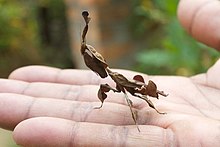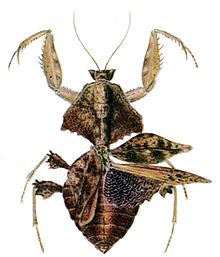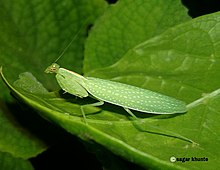Deroplatyinae[1] is a subfamily in the new (2019) family Deroplatyidae, containing species found in South-East Asia.
| Deroplatyinae | |
|---|---|
 | |
| Adult Deroplatys |
https://en.wikipedia.org/wiki/Deroplatyinae
The Majangidae[1] are a revived (2019) family of praying mantids from Madagascar.
| Majangidae | |
|---|---|
 | |
| Adult female Brancsikia freyi |
https://en.wikipedia.org/wiki/Majangidae
Liturgusidae is a family of praying mantids in the new (2019) Neotropical superfamily Acanthopoidea. A substantial number of genera, previously placed here, have recently been moved to the new or revived other families:[1]
| Liturgusidae | |
|---|---|
 | |
| Liturgusa maya |
https://en.wikipedia.org/wiki/Liturgusidae
The Nanomantidae are a new (2019) family of praying mantises, based on the type genusNanomantis. As part of a major revision of mantid taxonomy,[1] genera and tribes have been moved here, substantially replacing the old family Iridopterygidae.
| Nanomantidae | |
|---|---|
 | |
| Hyalomantis punctata |
https://en.wikipedia.org/wiki/Nanomantidae
Iridopterygidae was a family of praying mantids in the order Mantodea whose members, having formerly been moved here as a subfamily within Mantidae,[1] have now been transferred elsewhere as part of the recent (2019) major revision of mantid taxonomy.[2]
| Iridopterygidae | |
|---|---|
 | |
| Hapalopeza nilgirica, Kadavoor |
https://en.wikipedia.org/wiki/Iridopterygidae
Tropidomantinae is a subfamily of mantids in the new (2019) family Nanomantidae.[1]Within the single tribe Tropidomantini there are six genera, distributed in Asia and the Pacific.[2]
| Tropidomantinae | |
|---|---|
 | |
| Eomantis guttatipennis (previously placed in Tropidomantis) |
https://en.wikipedia.org/wiki/Tropidomantinae
Mantises are an order (Mantodea) of insects that contains over 2,400 species in about 460 genera in 33 families. The largest family is the Mantidae ("mantids"). Mantises are distributed worldwide in temperate and tropical habitats. They have triangular heads with bulging eyes supported on flexible necks. Their elongated bodies may or may not have wings, but all Mantodea have forelegs that are greatly enlarged and adapted for catching and gripping prey; their upright posture, while remaining stationary with forearms folded, has led to the common name praying mantis.
| Mantis | |
|---|---|
 | |
| Scientific classification | |
| Kingdom: | Animalia |
| Phylum: | Arthropoda |
| Class: | Insecta |
| Superorder: | Dictyoptera |
| Order: | Mantodea Burmeister, 1838 |
| Families | |
see text | |
| Synonyms | |
| |
https://en.wikipedia.org/wiki/Mantis
No comments:
Post a Comment